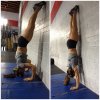@Harald Motz: If I may throw in my 2 cents.
It is clear to me that your Handstand comes from a lot of back-to-wall practice. Maybe I'm wrong but judging from the arch and the way you bail. Also, I don't think tucking your chin is helping much.
The issue isn't mobility or strength. From your bridge, I can tell you can open your shoulders. The issue is from activation. If you're mostly used to keeping closed shoulders and arched back, feeling the weight by the fingers, that's what you will always default to.
You can try to re-align your Handstands, but it makes more sense to me to just train them on the wall again, focusing on open shoulders and the hollow position. Yeah, it means swallowing a lot of pride though.
I few other things:
1) Do not bail by going onto a bridge. This is one big reason as to why you keep your feet so back, to help you catch a fall. Learn to twist away and land normally. This is a prereq for learning the HS STW but if you mostly do BTW, it's something you might have little experience with. You will never be comfortable having your feet vertical, if you need them all the way arched back to catch you.
2) Do not use the Crow to get to the HS. It will encourage closed shoulders (because that's how you start) and bent arms (which you seem to have from time to time). Kicking into the HS takes time to master because you don't start with the balance but once you
do master it, it will be the ticket to a very effortless and straight HS. Think of it as an investment.
Bent arm pressing (like Crow to HS) is actually rarely recommended, if ever, in gymnastics because it leads to bad Handstands. This is very telling.
3) Improve shoulder mobility and core strength. Like I said, activation is important. You should be training your hollow body hard (Front Lever is good, but whatever floats your boat). Band Dislocates are a must.
For reference, if you train STW since Day 1, a lot of these issues fix themselves. Here's my current HS:

Still some work to be done, but it is easier from here because it is just a matter of opening the shoulders a bit more, and hollowing out a tiny bit more.
Hope that helps and I'm sorry if it sounds like I'm just bashing you. I truly mean it in the most helpful way



